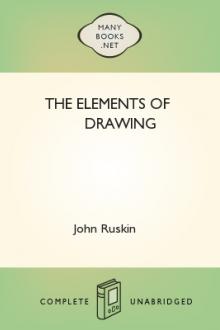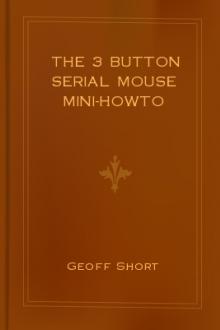The Elements of Drawing by John Ruskin (smart books to read .txt) 📕

xii. One task, however, of some difficulty, the student will find I have not imposed upon him: namely, learning the laws of perspective. It would be worth while to learn them, if he could do so easily; but without a master's help, and in the way perspective is at present explained in treatises, the difficulty is greater than the gain. For perspective is not of the slighte
Read free book «The Elements of Drawing by John Ruskin (smart books to read .txt) 📕» - read online or download for free at americanlibrarybooks.com
- Author: John Ruskin
- Performer: -
Read book online «The Elements of Drawing by John Ruskin (smart books to read .txt) 📕». Author - John Ruskin
110. In this exercise, as in the former one, a quarter of an inch worked to close resemblance of the copy is worth more than the whole subject carelessly done. Not that in drawing afterwards from Nature you are to be obliged to finish every gradation in this way, but that, once having fully accomplished the drawing something rightly, you will thenceforward feel and aim at a higher perfection than you could otherwise have conceived, and the brush will obey you, and bring out quickly and clearly the loveliest results, with a submissiveness which it would have wholly refused if you had not put it to severest work. Nothing is more strange in art than the way that chance and materials seem to favor you, when once you have thoroughly conquered them. Make yourself quite independent of chance, get your result in spite of it, and from that day forward all things will somehow fall as you would have them. Show the camel's hair, and the color in it, that no bending nor blotting is of any use to escape your will; that the touch and the shade shall finally be right, if it costs you a year's toil; and from that hour of corrective conviction, said camel's hair will bend itself to all your wishes, and no blot will dare to transgress its appointed border. If you cannot obtain a print from the Liber Studiorum, get a photograph[28] of some general landscape subject, with high hills and a village or picturesque town, in the middle distance, and some calm water of varied character (a stream with stones in it, if possible), and copy any part of it you like, in this same brown color, working, as I have just directed you to do from the Liber, a great deal with the point of the brush. You are under a twofold disadvantage here, however; first, there are portions in every photograph too delicately done for you at present to be at all able to copy; and, secondly, there are portions always more obscure or dark than there would be in the real scene, and involved in a mystery which you will not be able, as yet, to decipher. Both these characters will be advantageous to you for future study, after you have gained experience, but they are a little against you in early attempts at tinting; still you must fight through the difficulty, and get the power of producing delicate gradations with brown or gray, like those of the photograph.
111. Now observe; the perfection of work would be tinted shadow, like photography, without any obscurity or exaggerated darkness; and as long as your effect depends in anywise on visible lines, your art is not perfect, though it may be first-rate of its kind. But to get complete results in tints merely, requires both long time and consummate skill; and you will find that a few well-put pen lines, with a tint dashed over or under them, get more expression of facts than you could reach in any other way, by the same expenditure of time. The use of the Liber Studiorum print to you is chiefly as an example of the simplest shorthand of this kind, a shorthand which is yet capable of dealing with the most subtle natural effects; for the firm etching gets at the expression of complicated details, as leaves, masonry, textures of ground, etc., while the overlaid tint enables you to express the most tender distances of sky, and forms of playing light, mist, or cloud. Most of the best drawings by the old masters are executed on this principle, the touches of the pen being useful also to give a look of transparency to shadows, which could not otherwise be attained but by great finish of tinting; and if you have access to any ordinarily good public gallery, or can make friends of any printsellers who have folios either of old drawings, or facsimiles of them, you will not be at a loss to find some example of this unity of pen with tinting. Multitudes of photographs also are now taken from the best drawings by the old masters, and I hope that our Mechanics' Institutes and other societies organized with a view to public instruction, will not fail to possess themselves of examples of these, and to make them accessible to students of drawing in the vicinity; a single print from Turner's Liber, to show the unison of tint with pen etching, and the "St. Catherine," photographed by Thurston Thompson from Raphael's drawing in the Louvre, to show the unity of the soft tinting of the stump with chalk, would be all that is necessary, and would, I believe, be in many cases more serviceable than a larger collection, and certainly than a whole gallery of second-rate prints. Two such examples are peculiarly desirable, because all other modes of drawing, with pen separately, or chalk separately, or color separately, may be seen by the poorest student in any cheap illustrated book, or in shop windows. But this unity of tinting with line he cannot generally see but by some special inquiry, and in some out of the way places he could not find a single example of it. Supposing that this should be so in your own case, and that you cannot meet with any example of this kind, try to make the matter out alone, thus:
112. Take a small and simple photograph; allow yourself half an hour to express its subjects with the pen only, using some permanent liquid color instead of ink, outlining its buildings or trees firmly, and laying in the deeper shadows, as you have been accustomed to do in your bolder pen drawings; then, when this etching is dry, take your sepia or gray, and tint it over, getting now the finer gradations of the photograph; and, finally taking out the higher lights with penknife or blotting paper. You will soon find what can be done in this way; and by a series of experiments you may ascertain for yourself how far the pen may be made serviceable to reinforce shadows, mark characters of texture, outline unintelligible masses, and so on. The more time you have, the more delicate you may make the pen drawing, blending it with the tint; the less you have, the more distinct you must keep the two. Practice in this way from one photograph, allowing yourself sometimes only a quarter of an hour for the whole thing, sometimes an hour, sometimes two or three hours; in each case drawing the whole subject in full depth of light and shade, but with such degree of finish in the parts as is possible in the given time. And this exercise, observe, you will do well to repeat frequently, whether you can get prints and drawings as well as photographs, or not.
113. And now at last, when you can copy a piece of Liber Studiorum, or its photographic substitute, faithfully, you have the complete means in your power of working from Nature on all subjects that interest you, which you should do in four different ways.
First. When you have full time, and your subject is one that will stay quiet for you, make perfect light and shade studies, or as nearly perfect as you can, with gray or brown color of any kind, reinforced and defined with the pen.
114. Secondly. When your time is short, or the subject is so rich in detail that you feel you cannot complete it intelligibly in light and shade, make a hasty study of the effect, and give the rest of the time to a Düreresque expression of the details. If the subject seems to you interesting, and there are points about it which you cannot understand, try to get five spare minutes to go close up to it, and make a nearer memorandum; not that you are ever to bring the details of this nearer sketch into the farther one, but that you may thus perfect your experience of the aspect of things, and know that such and such a look of a tower or cottage at five hundred yards off means that sort of tower or cottage near; while, also, this nearer sketch will be useful to prevent any future misinterpretation of your own work. If you have time, however far your light and shade study in the distance may have been carried, it is always well, for these reasons, to make also your Düreresque and your near memoranda; for if your light and shade drawing be good, much of the interesting detail must be lost in it, or disguised.
115. Your hasty study of effect may be made most easily and quickly with a soft pencil, dashed over when done with one tolerably deep tone of gray, which will fix the pencil. While this fixing color is wet, take out the higher lights with the dry brush; and, when it is quite dry, scratch out the highest lights with the penknife. Five minutes, carefully applied, will do much by these means. Of course the paper is to be white. I do not like studies on gray paper so well; for you can get more gradation by the taking off your wet tint, and laying it on cunningly a little darker here and there, than you can with body-color white, unless you are consummately skillful. There is no objection to your making your Düreresque memoranda on gray or yellow paper, and touching or relieving them with white; only, do not depend much on your white





Comments (0)